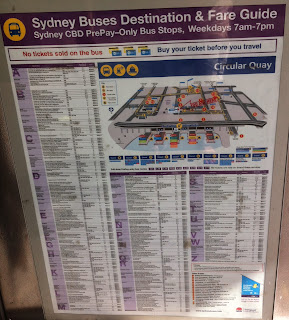
The 13 Dec brochure had the diagrams above purporting to show the numbers of buses that would be removed from the CBD during the morning peak hour by the trams. I apologize for reproducing such deceptive diagrams in an impeccable blog. PUSH has asked TfNSW in writing to clarify which bus services would be terminated only to be told that bus routes are still being modelled. This will still be the case when the ESI is released.
In fact TfNSW is only claiming the "light rail would take 180 buses out of the CBD while additional bus network changes would bring this to a total of about 220 fewer buses entering the city centre in the morning peak hour." However more than half the buses "taken out of the city centre" are passing tangentially to the CBD along Eddy Avenue to "Railway Square" - the bus layover in Lee Street. It is easy enough to generate these figures - just download the time tables and add up the buses during the chosen hour, but the data is meaningless without knowing the patronage at different stages of the route.
Bus services from the south east are spoiled for choice of how to approach the city:
- Cleveland Street then Chalmers Street
- Foveaux Street
- Flinders Street, Oxford Street then Liverpool Street
- The Eastern Distributor from Drivers Triangle to Bent Street
The X factor
 |
| Major bus routes from south east |
 |
| Bent Street, 9 AM |
The buses are packed, as you would expect, since Bent Street is an office-space hub with Aurora Place, Chifley Tower, the Governor Macquarie and Governer Phillip towers and the new Richard Rogers designed tower, 8 Chifley. Then there are the office towers at Martin Place.
Commuters in Coogee and Maroubra, with the trams, will have a choice of:
- an express bus service travelling at 60 kph in the exclusive bus roadway, having, potentially, priority entry to the expressway then travelling at 80 kph to Bent Street, or
- catch a bus that dumps them a long way east of Cuthill Street in Coogee Bay Road or a long way south of Cuthill Street in Perouse Road, then circles the Randwick Triangle while they trudge through rain, hail and sleet to the Randwick Triangle, then wait up to 6 minutes in peak periods to transfer to a cattle car (see the post on the Randwick Triangle). TfNSW claims there will be a 20 minute journey time to Central Station then a 15 minute journey time to Circular Quay, but these assertions are based on infantile assumptions - TfNSW will not allow expert modelling. The cattle cars will in fact be travelling at 10 kph through the "pedestrianized" areas. Even accepting the figures, the journey times, not including the time for walking and waiting for the cattle cars, are more than twice the times currently achieved by the bus services.
Fortunately, it is ridiculously easy for future State Governments to reverse this decision. Investors contemplating investing in a PPP (Private Public Partnership) will need to bear this in mind. The O'Farrell Government has suffered swings in by-elections greater than those seen in the Wranslides.
The arguments above also apply to the Xnn services along Anzac Parade but we do not have enough information on the tram stops along Anzac Parade to elaborate at this time.
The Xnn bus services from the south east cannot be crushed as they avoid the bridgehead in Elizabeth Street northbound at the Old Supreme Court Building. It is physically impossible, however, for the bus services displaced from George Street by the tramway - the Parramatta Road and City Road services and the Harbour Bridge to Railway Square services - to avoid this bottleneck. They are completely and irretrievably ... mind your p's and q's.














































